|
Battle of Hatteras Inlet Batteries
North Carolina Coast and the Civil War
Hatteras Inlet Batteries
Other Names: Battle of Forts Clark and Hatteras; Battle of Hatteras
Location: Dare County
Campaign: Blockade of the Carolina Coast (August-December 1861)
Date(s): August 28-29, 1861
Principal Commanders: Maj. Gen. Benjamin F. Butler [US]; Col.
William F. Martin [CS]
Forces Engaged: 9th and 20th New York regiments (est. 2,000)
[US]; Hatteras Island Garrison (900) [CS]
Estimated Casualties: 715 total (US 3;
CS 712)*
Result(s): Union victory
| NC Outer Banks |
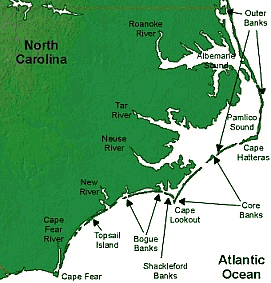
|
| North Carolina Coast: A Civil War History |
Description: The blockade of North Carolina's coast, which included
the action of Hatteras Inlet, was a strategic objective in Gen. Winfield Scott's Anaconda Plan. On August 26, an amphibious expedition led by Maj. Gen. Benjamin Butler and Flag-Officer Silas Stringham,
embarked from Fort Monroe to capture Hatteras Inlet, an important haven for blockade-runners. On the 28th, while the navy
bombarded forts Clark and Hatteras, Union troops came ashore and attacked the rear of the Confederate batteries. On August 29, Col. William F. Martin surrendered the Confederate garrison of 670. The
Federals lost only one man. Butler next returned to Fort Monroe, leaving the captured forts garrisoned. This movement was
part of Union efforts to seize coastal enclaves from which to enforce the blockade. During World War II, because of the
numerous allied ships sunk by German U-boats, the waters off Cape Hatteras became known
as Torpedo Alley.
Background:
The North Carolina Sounds occupy most of the coast
from Point Lookout to the Virginia border. With their eastern borders marked by the Outer Banks, they were almost
ideally located for raiding Northern maritime commerce. Cape Hatteras,
the easternmost point in the Confederacy, is within sight of the Gulf Stream. Ships in the
Caribbean trade would reduce the time of their homeward journeys to New York, Philadelphia,
or Boston by riding the stream to the north. Raiders, either
privateers or state-owned vessels, could lie inside, protected from both the weather and from Yankee blockaders, until an
undefended victim appeared. Watchers stationed at the Hatteras lighthouse would then signal a raider, which would dash out
and make a capture, often being able to return the same day.
To protect the raiders from
Federal reprisal, the state of North Carolina, immediately after seceding from the Union, established forts at the inlets, the waterways that allowed entrance to and egress from
the sounds. In 1861, only four inlets were deep enough for ocean-going vessels to pass: Beaufort, Ocracoke, Hatteras, and
Oregon Inlets. Two forts, Hatteras and Clark, were built on Hatteras Inlet because it was considered the most important.
Fort Hatteras was sited adjacent to the inlet, on the sound side of Hatteras Island.
Fort Clark was about half a mile to the
southeast, closer to the Atlantic Ocean. The forts were improperly armed for coastal
defense, however. Fort Hatteras had
only ten guns mounted by the end of August, with another five guns in the fort but not mounted. Fort Clark had only five. Furthermore, most
of the guns were rather light 32-pounders or smaller, of limited range and inadequate for coastal defense.
| Battle of Fort Hatteras Civil War History |
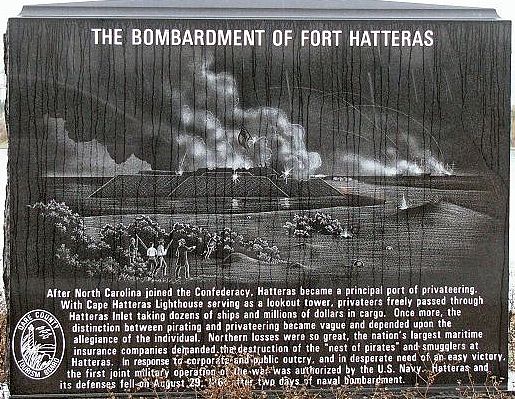
|
| Battle of Hatteras Inlet |
| Battle of Hatteras Inlet History |
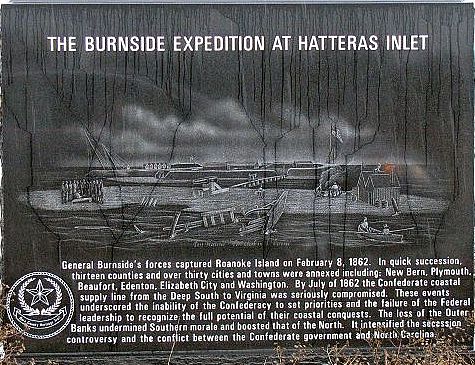
|
| Burnside Expedition and Hatteras Inlet |
The personnel problem was even worse. North Carolina had raised and equipped 22 infantry regiments to serve in the war, but 16
of these had been drawn off for the campaigns in Virginia.
The six regiments remaining were responsible for the defense of the entire North
Carolina coastline. Only a fraction of one regiment, the 7th North Carolina Volunteers, occupied the
two forts at Hatteras Inlet. The other forts were likewise undermanned. Fewer than a thousand men garrisoned forts Ocracoke,
Hatteras, Clark, and Oregon. Reinforcements, if needed,
would have to come from as far away as Beaufort.
Strangely, the military
authorities in North Carolina did little to keep the poor
state of their defenses secret. Several Yankee captains, victims of either capture or shipwreck, were loosely detained at
or near Hatteras Island while awaiting return to their homes. They were allowed virtually
free access to the forts, and made mental notes of everything. When they returned to the North, at least two of them gave
full and valuable descriptions to the Navy Department.
The depredations on Northern commerce
emanating from Hatteras Inlet could not pass unnoticed. Insurance underwriters pressured Union Secretary of the Navy Gideon
Welles for remedy. Welles needed no prodding. He already had on his desk a report from the Blockade Strategy Board suggesting
a way to perfect the blockade of the North Carolina coast.
The board recommended that the coast be rendered useless to the South by sinking old ballast-laden ships in the inlets to
"block them up." (Their reports also contained a statement that is easily overlooked: "These plans may undergo some modification
in the hands of the person to whom their execution shall be intrusted.")
Soon after he received the
board's report, Secretary Welles began to implement its recommendation. He ordered Commander H. S. Stellwagen to go to the
Chesapeake Bay to buy some suitable old hulks. At the same time, he was told to report his
activities to Flag Officer Silas H. Stringham, commandant of the Atlantic Blockading Squadron. As such, he was the naval officer
in charge of the blockade of the North Carolina coast. This
was the first involvement of Stringham with what was to become the attack at Hatteras Inlet.
| Battle of Hatteras Inlet History |
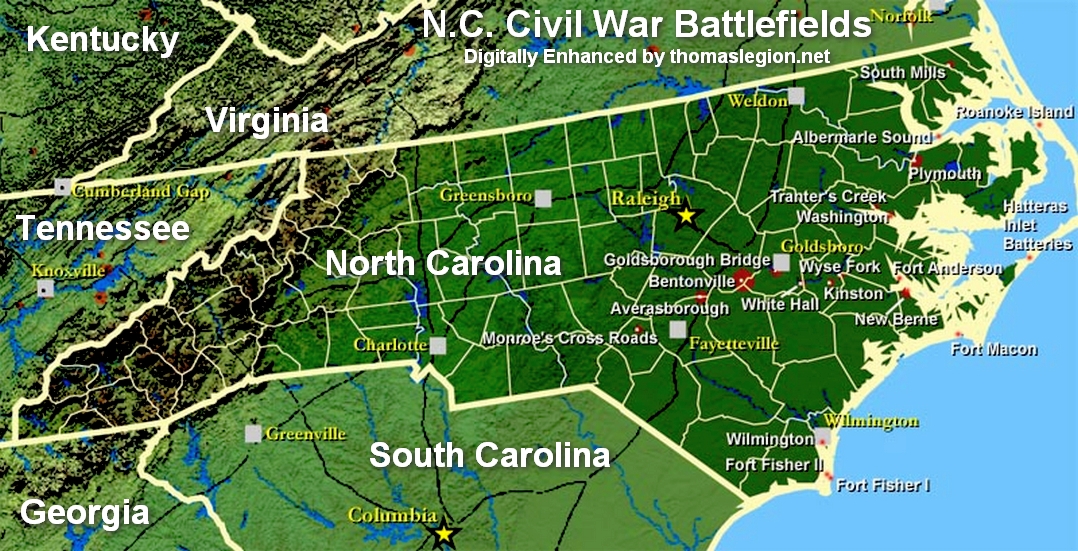
|
| North Carolina Civil War Battlefields |
Stringham opposed
the plan to block the inlets from the beginning. He believed that the tidal currents would either sweep the impediments away
or would rapidly scour new channels. He further believed that the Rebels could not be denied access to the sounds unless the
inlets were actually held by the Union. The Federals would have to take the fight to Hatteras. The objective was to silence the
guns and capture the forts, and it would require a joint Union Army and Navy command.
Gen. Benjamin F. Butler,
who was deemed by some as incompetent, was to assemble a force of some 800 men for the expedition. He soon had 880: 500 from
the German-speaking 20th New York Volunteers, 220 from the 9th New York Volunteers, 100 from the U.S. Revenue Cutter Service (99th New York Volunteers), and 20 soldiers from the 2nd U.S. Artillery. The men were deployed to vessels Adelaide and George Peabody. When objection was made that the two ships
would not be able to survive a Hatteras storm, Stellwagen pointed out that the expedition could proceed only in fair weather
anyway because a storm would prevent any amphibious assault.
Meanwhile, while Butler was gathering his forces, Flag Officer Stringham was also making
preparations. Stringham learned that the War Department had issued orders to Butler's
superior, Major General John E. Wool, with the statement, "The expedition originated in the Navy Department, and is under
its control." Reasoning that he would be blamed if anything went wrong, he seized the initiative and selected seven warships
for the expedition: USS Minnesota, USS Cumberland, USS Susquehanna, USS Wabash, USS Pawnee,
USS Monticello, and USRC Harriet Lane. With the exception of USRC Harriet Lane, the ships belonged to the
U.S. Navy. He also included in his force the tug Fanny, which was needed to tow some of the surf boats that would be used
for the landing.
On August 26, 1861,
the flotilla, less Susquehanna and Cumberland, departed Hampton Roads and moved down
the coast to the vicinity of Cape Hatteras.
En route, they were joined by the Cumberland. They swung around the Cape on August 27 and
anchored near the inlet, in full view of the defenders there. Colonel William F. Martin of the 7th North Carolina Infantry,
commanding forts Hatteras and Clark,
knew that his 580 or so men would need help, so he called for reinforcements from forts Ocracoke and Oregon. Unfortunately, communication among the forts was slow, and the first reinforcements
did not arrive until late the next day.
| NC Coastal Defenses and the Outer Banks |
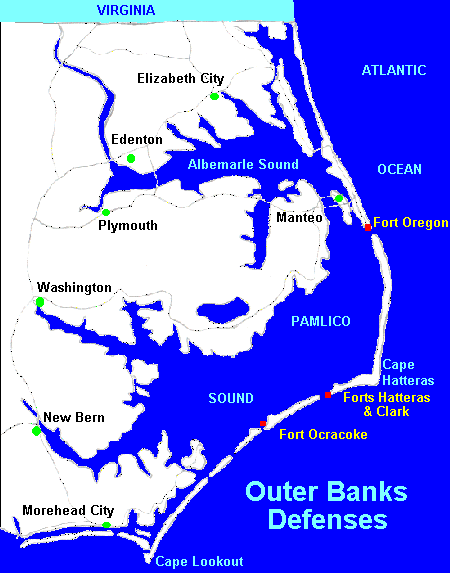
|
| Battle of Hatteras Inlet Batteries. Courtesy Microsoft TerraServer. |
| North Carolina Coast and the Civil War |
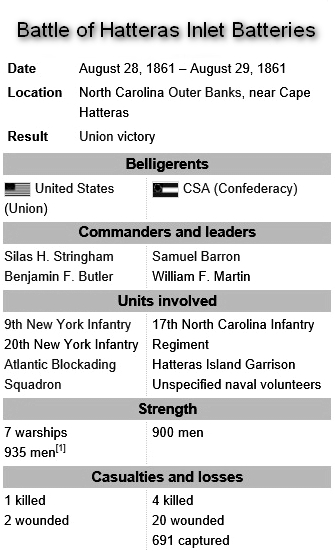
|
| Battle of Forts Clark and Hatteras |
1Update to the Civil War Sites Advisory
Commission Report.
Battle:
The Battle of Hatteras Inlet Batteries, part of the Federal Navy's Blockade of the Carolina Coast from August to December 1861, was the initial Union sea and land
assault against the North Carolina coast. The Blockade would be followed-up with Burnside's North Carolina Expedition from February to June 1862.
The fight at Hatteras
was a relatively small but significant engagement in the early days of the Civil War. Two Confederate forts on the North
Carolina Outer Banks were subjected to an amphibious assault by Union forces that began on August 28, 1861. The ill-equipped and undermanned
forts were forced to endure bombardment by seven Union warships, to which they were unable to reply. Although casualties were
light, the defenders chose not to continue the one-sided contest, and on the second day they surrendered. As immediate results
of the battle, Confederate interference with Northern maritime commerce was considerably reduced, while the Union blockade
of Southern ports was extended. More importantly, the Federals gained entry into the North Carolina sounds. Several North Carolina cities
(New Bern, Washington, Elizabeth City, and Edenton among them) were
directly threatened. In addition, the sounds were a back door to the Confederate-held parts of Tidewater Virginia,
particularly Norfolk.
First Day: Early on the morning of August 28, USS Minnesota, USS Wabash, and USS Cumberland
began to bombard Fort Clark, while the lighter warships accompanied the transports to a point about three miles to the east,
where the troops began disembarking. Stringham kept his ships moving in a loop, with Wabash towing Cumberland. About 11:00 a.m., USS Susquehanna "made her number" and joined in. The ships
would deliver their broadsides against the fort, move back out of range to reload, and then come back in to fire again. By
remaining in motion, they did not let the artillerymen in the fort correct their aim between shots, and thereby negated much
of the traditional advantage of shore-based guns over those on ships. This tactic had been used previously by the British
and French at the siege of Sevastopol in the Crimean War,
but this was the first time it was used by the US Navy.
The return fire from Fort Clark was ineffectual,
either falling short or passing overhead, and no hits were made on the bombarding ships. Shortly after noon, the defenders
ran low on ammunition, and about 12:25 p.m. they ran out completely. At this point, they abandoned the fort, some fleeing
to Fort Hatteras,
while others took to boats. Col. Max Weber, commanding the Federal troops already on shore, noted this and moved some
men in to take possession, but the fleet was unaware of the movement and continued firing for another five minutes. It was
during this interval of confusion that the landing force suffered its only casualty, one of the soldiers being seriously wounded
in the hand by a shell fragment. Fortunately, some of the troops were able to contact the gunners on the ships by waving a
large American flag, and the bombardment stopped with no further casualties. Stringham and his captains then turned their
full attention to Fort Hatteras.
Meanwhile, the landings
were not going well. Only about a third of the troops were ashore when rising winds produced surf that swamped and overturned
the landing boats, and General Butler had to suspend further attempts to land. Colonel Weber found that he had only 318 men
with him. The number included 102 from his own regiment, the 20th New York, but also 68 from
the 9th New York, 28 from the Revenue Service, 45 artillerymen,
45 marines, and 28 sailors who could man heavy guns. With a couple of field pieces that they had managed to wrestle ashore
through the surf, they could reasonably well defend themselves against a Confederate counterattack, but they were too weak
to mount an attack on Fort Hatteras.
| Civil War Battle of Hatteras Inlet Batteries |

|
| Civil War Battle of Fort Hatteras, North Carolina |
At Fort Hatteras,
Stringham kept his ships moving as he had done at Fort Clark. The Confederates tried to conserve their ammunition by firing only sporadically,
so Stringham thought that perhaps the fort had been abandoned. (No flag was flying. Before the battle, the old flag had been
reduced to tatters, and was never replaced.) He sent Monticello
into the inlet to sound it out, but then the fort came again to life. The ship grounded while trying to extricate herself,
and in this condition she was struck by five shots. None of these did any permanent damage, although a couple of sailors received
minor wounds.
As the day came to a close,
the fleet withdrew in the face of threatening weather, the exhausted defenders looked for reinforcements, and the Federal
troops ashore went to sleep without rations, with water running low, and dreading the reinforcements that their opponents
hoped for.
After sunset, reinforcements
began to arrive at the fort. The gunboat CSS Warren Winslow brought in some of the garrison from Fort Ocracoke, and some of the sailors also
stayed to help man the guns. This brought the number of men in the fort up to more than 700, with more expected from New Bern. Accompanying the additional troops was Flag Officer Samuel
Barron, commanding the coast defenses of North Carolina and Virginia. Colonel Martin, pleading exhaustion, requested Barron to assume command. He did
so, still believing that with the additional troops from New Bern they would be able to retake
Fort Clark.
Second Day: Dawn
of the second day dashed the hopes of the defenders. While the weather moderated enough so that the Union fleet
could return and resume its bombardment, it was also able to drive off the transport bringing reinforcements. (One ship was
able to reach the fort, but rather than bringing in more troops she carried away some of the wounded.) The fleet initially
kept in motion, but they soon found that they were out of range of the guns in the fort. Next, the ships did not alter their
positions, but poured their fire into the fort with no danger of reply. There was nothing the men in the forts could do except
endure. After about three hours, Barron called a council of the officers, and they decided to seek terms, even though casualties
had been quite light. (The actual numbers of dead and wounded remain unknown. Conflicting reports placed the number
of dead from four to seven and the wounded from 20 to 45.) Shortly after 11:00 a.m., the white flag was raised.
Butler insisted upon surrender, which Barron agreed to. The
battle came to a close, and the surrendered Confederates were sent to prisoner-of-war camps. The list of prisoners
had 691 names, including those wounded but not evacuated.
Union Order of Battle
Department of Virginia,
Major General Benjamin F. Butler
9th New York Infantry Regiment,
Colonel Rush Hawkins (220 men)
20th New York Infantry Regiment,
Colonel Max Weber (500 men)
99th New York Infantry Regiment
("U.S. Revenue Service"), Capt. William Nixon (100 men)
Detachment, U.S. 2nd Artillery, Lt. Frank H. Larned (60 men)
Detachments of sailors and marines
from the fleet
Atlantic Blockading Squadron,
Flag Officer Silas H. Stringham
U.S.S. Monticello
U.S.S. Harriet Lane
U.S.S. Minnesota
U.S.S. Wabash
U.S.S. Susquehanna
U.S.S. Cumberland
U.S.S. Pawnee
U.S.S. Fanny
Confederate Oder
of Battle
17th North Carolina Infantry Regiment
(1st Organization) - Colonel William F. Martin
Forts Hatteras &
Clark - Colonel Andrews
Unspecified naval volunteers, including Flag Officer Samuel Barron
Aftermath: The
battle was significant for several reasons: Following the embarrassment of the Battle of First Bull Run (or First Manassas),
July 21, 1861, it was the first notable Union victory of the war. It was also the first application of the naval blockading
strategy. As an amphibious operation, it was the first use of joint Union Army and Navy units during the conflict. The
Federal ships successfully bombarded the forts while moving and cruising along the coast, making it too
difficult for the shore-based batteries to score a direct hit.
Butler
and Stringham left immediately after the battle, the former to Washington and the latter
accompanying the prisoners to New York. Critics argued that
each was trying to gather credit for the victory to himself. The pair contended, however, that they were trying to persuade
the administration to abandon the original plan to block up Hatteras Inlet. In Federal hands it was no longer useful to the
Confederacy, and in fact now allowed Union forces to pursue raiders into the sounds. Although they and their supporters continued
to press the case for several weeks, it seems to have been unnecessary. The War and Navy Departments had already decided to
retain possession of the inlet, which would be used as the entry point of an amphibious expedition against the North Carolina mainland early the next year. This campaign, known as
Burnside's North Carolina Expedition, would completely remove the sounds as sources of commerce-raiding activity.
Continued Federal possession of
Hatteras Inlet was considerably aided by Confederate authorities, who had decided to abandon Ocracoke and Oregon batteries believing they were indefensible. Stingham's tactic of keeping his ships
in motion while bombarding forts was used later by Flag Officer Samuel Francis Du Pont at Port
Royal, South Carolina. The effectiveness of the practice led to a
reconsideration of the value of forts against naval gunnery. See also North Carolina Coast and the
American Civil War.
*Depending on the source, casualty figures vary slightly.
(References listed at bottom of page.)
Recommended Reading: The
Civil War on the Outer Banks: A History of the Late Rebellion Along the Coast of North Carolina from Carteret to Currituck
With Comments on Prewar Conditions and an Account of (251 pages). Description: The ports at Beaufort, Wilmington, New Bern and Ocracoke, part of the Outer Banks (a chain
of barrier islands that sweeps down the North Carolina coast from the Virginia Capes to Oregon Inlet), were strategically
vital for the import of war materiel and the export of cash producing crops. From official records, contemporary newspaper
accounts, personal journals of the soldiers, and many unpublished manuscripts and memoirs, this
is a full accounting of the Civil War along the North Carolina
coast.
Advance to:
Recommended
Reading: Portrait of the Past : The Civil War
on Hatteras Island North Carolina (Portrait of the Past) (Hardcover). Description:
Hatteras Island has achieved a well-deserved reputation as a summer getaway and a wildlife refuge on North Carolina's coast.
However, most visitors are unaware of the crucial role that Hatteras played in the Civil War. The book offers a new view of
Hatteras's history, interweaving historical facts, archival drawings, and current photography of how the island looks today.
In addition, the book reveals the largely unknown journals of Edwin Graves Champney, a Union soldier who was stationed on
Hatteras from 1862 to 1863. Continued below…
Champney's
prose and artistic talents, along with the quotes of soldier Charles F. Johnson of the Ninth New York, shed new light on the
experiences of Civil War soldiers stationed on the Outer Banks during that time. It follows the crucial maritime battles along
the Outer Banks and the famous Burnside Expedition. This is a fascinating history of how one of America's
most treasured islands played a significant part in the Civil War and is a must for any reader. About the Author: Author: Drew Pullen is a graduate of Houghton College and a former history teacher. He currently manages
the Hatteras and Ocracoke offices of the East Carolina Bank. As an amateur historian, he has written several articles on the
Civil War for local newspapers. His wife Jo Anne is from a local Hatteras family and her great-great grandfather was stationed
at Fort
Hatteras during the
Civil War. Drew continues to research Civil War action in eastern North Carolina for future books.
Recommended Reading: The
Civil War in Coastal North Carolina (175 pages) (North Carolina Division of Archives and History). Description: From the drama of blockade-running to graphic descriptions of battles
on the state's islands and sounds, this book portrays the explosive events that took place in North Carolina's
coastal region during the Civil War. Topics discussed include the strategic importance of coastal North Carolina, Federal occupation of coastal areas, blockade-running, and the impact of
war on civilians along the Tar Heel coast.
Recommended Reading: Ironclads and Columbiads: The Coast
(The Civil War in North Carolina) (456 pages). Description: Ironclads and Columbiads covers some of the most
important battles and campaigns in the state. In January 1862, Union forces began in earnest to occupy crucial points on the
North Carolina coast. Within six months, Union army and
naval forces effectively controlled coastal North Carolina from the Virginia
line south to present-day Morehead City.
Union setbacks in Virginia, however, led to the withdrawal of many federal soldiers from North Carolina, leaving only enough
Union troops to hold a few coastal strongholds—the vital ports and railroad junctions. The South during the Civil War,
moreover, hotly contested the North’s ability to maintain its grip on these key coastal strongholds.
Recommended Reading: Storm
over Carolina: The Confederate Navy's Struggle for Eastern North Carolina. Description: The struggle for control of the eastern
waters of North Carolina during the War Between the States
was a bitter, painful, and sometimes humiliating one for the Confederate navy. No better example exists of the classic adage,
"Too little, too late." Burdened by the lack of adequate warships, construction facilities, and even ammunition, the
South's naval arm fought bravely and even recklessly to stem the tide of the Federal invasion of North
Carolina from the raging Atlantic. Storm
Over Carolina is the account of the Southern navy's struggle in North
Carolina waters and it is a saga of crushing defeats interspersed with moments of brilliant and even
spectacular victories. It is also the story of dogged Southern determination and incredible perseverance in the face
of overwhelming odds. Continued below...
For most of
the Civil War, the navigable portions of the Roanoke, Tar, Neuse, Chowan, and Pasquotank rivers were
occupied by Federal forces. The Albemarle and Pamlico sounds, as well as most of the coastal towns and counties, were also
under Union control. With the building of the river ironclads, the Confederate navy at last could strike a telling blow against
the invaders, but they were slowly overtaken by events elsewhere. With the war grinding to a close, the last Confederate vessel
in North Carolina waters was destroyed. William T. Sherman
was approaching from the south, Wilmington was lost, and the
Confederacy reeled as if from a mortal blow. For the Confederate navy, and even more so for the besieged citizens of eastern
North Carolina, these were stormy days indeed. Storm Over Carolina describes their story, their struggle, their history.
Recommended
Reading: Gray Raiders of the Sea: How Eight Confederate Warships Destroyed
the Union's High Seas Commerce. Reader’s Review: This subject is one of the most fascinating in the history of sea power, and the
general public has needed a reliable single-volume reference on it for some time. The story of the eight Confederate privateers
and their attempt to bring Union trade to a halt seems to break every rule of common sense. How could so few be so successful
against so many? The United States, after Great Britain, had the most valuable and extensive import/export trade in the world
by the middle of the 19th century. The British themselves were worried since they were in danger of being surpassed in the
same manner that their own sea traders had surpassed the Dutch early in the 18th century. Continued below…
From its founding
in 1861, the Confederate States of America realized it had a huge problem since it lacked a navy.
It also saw that it couldn't build one, especially after the fall of its biggest port, New
Orleans, in 1862. The vast majority of shipbuilders and men with maritime skills lived north of the
Mason-Dixon Line, in the United States, and mostly in New
England. This put an incredible burden on the Confederate Secretary of the Navy, Stephen R. Mallory. When he saw
that most of the enemy navy was being used to blockade the thousands of miles of Confederate coasts, however, he saw an opportunity
for the use of privateers. Mallory sent Archibald Bulloch, a Georgian and the future maternal grandfather of Theodore Roosevelt,
to England to purchase British-made vessels
that the Confederacy could send out to prey on Union merchant ships. Bulloch's long experience with the sea enabled him to
buy good ships, including the vessels that became the most feared of the Confederate privateers - the Alabama,
the Florida, and the Shenandoah. Matthew Fontaine Maury
added the British-built Georgia, and the Confederacy itself launched the
Sumter, the Nashville, the Tallahassee,
and the Chickamauga - though these were generally not as effective
commerce raiders as the first four. This popular history details the history of the eight vessels in question, and gives detailed
biographical information on their captains, officers, and crews. The author relates the careers of Raphael Semmes, John Newland
Maffitt, Charles Manigault Morris, James Iredell Waddell, Charles W. Read, and others with great enthusiasm. "Gray Raiders"
is a great basic introduction to the privateers of the Confederacy. More than eighty black and white illustrations help the
reader to visualize their dramatic exploits, and an appendix lists all the captured vessels. I highly recommend it to everyone
interested in the Confederacy, and also to all naval and military history lovers.
Sources: Official records of the
Union
and Confederate Navies in the War of the Rebellion. Series I: 27 volumes. Series II: 3 volumes. Washington:
Government Printing Office, 1894-1922; The War of the Rebellion: A Compilation of the Official Records of the Union
and Confederate Armies. Series I: 53 volumes. Series II: 8 volumes. Series III: 5 volumes. Series IV: 4 volumes. Washington: Government Printing Office, 1886-1901; Maury, Matthew F.,
The physical geography of the sea. New York: Harper and
Brothers, 1855; Simson, Jay W., Naval Strategies of the Civil War: Confederate Innovations and Federal Opportunism. Nashville: Cumberland House Publishing, 2001; Stick, David, The Outer
Banks of North Carolina, 1584–1958. Chapel Hill: University of North Carolina
Press, 1958; National Park Service.
|

